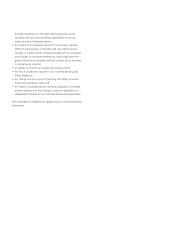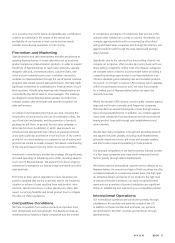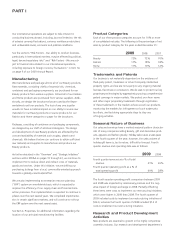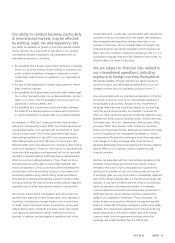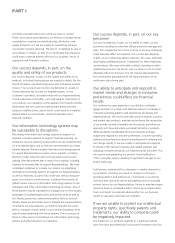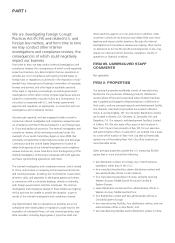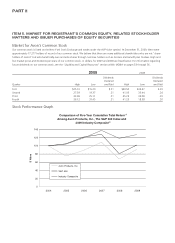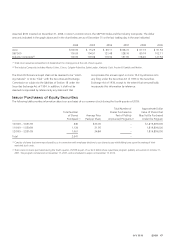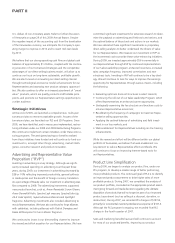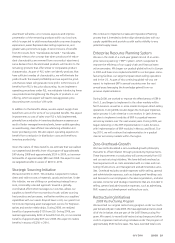Avon 2009 Annual Report Download - page 29
Download and view the complete annual report
Please find page 29 of the 2009 Avon annual report below. You can navigate through the pages in the report by either clicking on the pages listed below, or by using the keyword search tool below to find specific information within the annual report.model as well as to recruit and retain new Representatives. If we
are unable to do so our business will be adversely affected.
Within the broader CPG industry, we compete against large and
well-known cosmetics and fragrances companies that manufac-
ture and sell broad product lines through various types of retail
establishments. In addition, we compete against many other
companies that manufacture and sell in more narrow Beauty
product lines sold through retail establishments. This industry is
highly competitive, and some of our principal competitors in the
CPG industry are larger than we are and have greater resources
than we do. Competitive activities on their part could cause
our sales to suffer. We have many competitors in thehighly compe-
titive gift and decorative products and apparel industries globally,
including retail establishments, principally department stores, gift
shops and specialty retailers, and direct-mail companies specializing
in these products. Our principal competition in the highly
competitive fashion jewelry industry consists of afew large
companies and many small companies that sell fashion jewelry
through retail establishments.
The number of competitors and degree of competition that
we face in this beauty and related products industry varies
widely from country to country. If our advertising, promotional,
merchandising or other marketing strategies are not successful,
if we are unable to deliver new products that represent techno-
logical breakthroughs, if we do not successfully manage the
timing of new product introductions or the profitability of these
efforts, or if for other reasons our Representatives or end
customers perceive competitors’ products as having greater
appeal, then our sales and financial results may suffer.
Any future acquisitions may expose us to
additional risks.
We continuously review acquisition prospects that would comple-
ment our current product offerings, increase the size and geo-
graphic scope of our operations or otherwise offer growth and
operating efficiency opportunities. The financing for any of these
acquisitions could dilute the interests of our stockholders, result
in an increase in our indebtedness or both. Acquisitions may
entail numerous risks, including:
•difficulties in assimilating acquired operations or products,
including the loss of key employees from acquired businesses
and disruption to our direct-selling channel;
•diversion of management’s attention from our core business;
•adverse effects on existing business relationships with suppliers
and customers; and
•risks of entering markets in which we have limited or no
prior experience.
Our failure to successfully complete the integration of any
acquired business could have amaterial adverse effect on our
business, financial condition and operating results. In addition,
there can be no assurance that we will be able to identify suita-
ble acquisition candidates or consummate acquisitions on
favorable terms.
Third-party suppliers provide, among other
things, the raw materials used to
manufacture our Beauty products, and the
loss of these suppliers or adisruption or
interruption in the supply chain may
adversely affect our business.
We manufacture and package almost all of our Beauty products.
Raw materials, consisting chiefly of essential oils, chemicals,
containers and packaging components, are purchased from various
third-party suppliers for our Beauty products. Almost all of our
non-Beauty products are purchased from various suppliers.
Additionally, we produce the brochures that are used by
Representatives to sell Avon products. The loss of multiple suppliers
or asignificant disruption or interruption in the supply chain
could have amaterial adverse effect on the manufacturing and
packaging of our Beauty products, the purchasing of our
non-Beauty products or the production of our brochures. This
risk may be exacerbated by SSI, which will shift our purchasing
strategy toward aglobally-coordinated effort. Furthermore,
increases in the costs of raw materials or other commodities may
adversely affect our profit margins if we are unable to pass along
any higher costs in the form of price increases or otherwise
achieve cost efficiencies in manufacturing and distribution.
The loss of or adisruption in our
manufacturing and distribution operations
could adversely affect our business.
Our principal properties consist of worldwide manufacturing facil-
ities for the production of Beauty products, distribution centers
where offices are located and where finished merchandise is
packed and shipped to Representatives in fulfillment of their
orders, and one principal research and development facility.
Additionally, we also use third party manufacturers to manufac-
ture certain of our products. Therefore, as acompany engaged in
manufacturing, distribution and research and development on a
global scale, we are subject to therisks inherent in such activities,
including industrial accidents, environmental events, fires, strikes
and other labor or industrial disputes, disruptions in logistics or
information systems, loss or impairment of key manufacturing
or distribution sites, product quality control, safety, licensing
requirements and other regulatory or government issues, as well
as natural disasters, pandemics, border disputes, acts of terrorism
AVON2009 11



